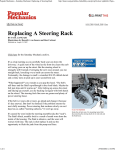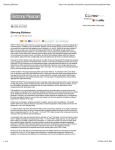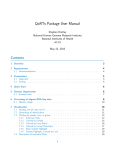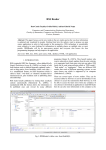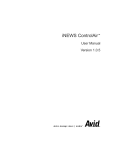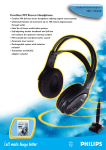Download Curing Radio Noise - College of Engineering Bhubaneswar
Transcript
Popular Mechanics - Saturday Mechanic: Curing Radio Noise
1 of 5
http://hearst.corp.printthis.clickability.com/pt/cpt?action=cpt&title=Popu...
SAVE THIS | EMAIL THIS | Close
Curing Radio Noise
BY MIKE ALLEN
Illustrations by Russell J. Von Sauers and Ron Carboni
Published on: November 12, 2002
Click here for the Saturday Mechanic archive.
You're looking forward to the chance to listen to the ballgame,
having just dropped your purple-haired teenage daughter off at her
first semester at college. A lot of ballgames, actually, now that you
don't have to listen to her headbanger music, with its shrieking
vocals and droning guitars. But instead of the first inning, you hear
what sounds like some awful guitar note--and it changes pitch as
you speed up and slow down, turning to a maniacal rhythmic
clicking as you wait for a traffic light to change. There's no tape in
the player. What you have here is radio frequency interference
(RFI).
Finding The Source
There are three classes of RF noise--constant, intermittent and
engine-speed following. Our hapless father's problem was in the
latter category--his noise varied up and down in pitch and volume
as his engine sped up and slowed down. This type of noise is
caused by something that varies its speed with the engine. Likely
culprits include the ignition, the alternator or even a fuel injector.
Constant-speed noises are usually caused by an electric
motor--most likely the electric fuel pump found in the tank of most
modern vehicles which runs at a constant speed anytime the engine
is running. An electric fan motor will also run at a constant
speed--until you change the fan setting or turn it off. Intermittent
noises are easier to associate with a source, such as an electric seat
adjuster or a power-window motor. In other words, even though the
noise comes from a radio speaker, it may be caused by any manner
of device anywhere on your vehicle.
This stereo power amp is getting an in-line noise filter
added to its power lead. Solder and PVC shrink tube
make for a noisefree, high-current splice.
Constants
The one motor that's guaranteed to be on whenever the car is
29/08/2006 2:31 PM
Popular Mechanics - Saturday Mechanic: Curing Radio Noise
2 of 5
http://hearst.corp.printthis.clickability.com/pt/cpt?action=cpt&title=Popu...
running is the fuel pump's, and unfortunately it's usually buried
inside the fuel tank. Here's one sure way to tell. Turn the key to the
Run position without starting the car. The pump should run for 2 or
3 seconds. Then, when the computer senses that the engine isn't
running, it will shut off the pump to prevent spilling fuel and
draining the battery. Other almost-constants are heater fans, wipers
and electric radiator-cooling fans.
Engine-Speed Noises
Candidates here include the alternator/voltage regulator, a faulty
fuel injector and the ignition system.
Geiger Counter Test
Here's our favorite low-tech tool for hunting down and killing wild
noises--a cheap AM radio. Tune it to an empty channel around
1400 kHz, crank up the volume in your headset, and use the radio
to sniff out the noise. These cheapo radios use a ferrite-bar antenna
that has good reception along its side, but poor reception along its
length. Once you find the noise within a few feet, turn the radio 90°
to minimize the noise. The top of the radio will point at the source
like a gunsight.
A cheap AM radio makes a good Geiger counter-style
device for hunting down RFI. Here, we're looking for
an alternator with a bad diode. Mind your fingers.
Making Sure
Find some way of disconnecting the source of the RFI and check to
see if the noise ceases. This will be difficult in the case of the fuel
pump or ignition, but you can pull the belt off the alternator. (Don't
disconnect the alternator electrically--the back EMF [voltage] may
smoke the diodes.) If you think it's a fuel injector, try
disconnecting it from the harness.
Plugged Up
Virtually all cars today use resistor-type plug cables if they use
spark plug wires at all. If your vehicle is more than a few years old,
degraded cables may be the source of the problem. Remove and
replace the cables one at a time, clean them of grease and dirt with
mild detergent, and check the connections to the ends. Now get out
your ohmmeter and measure the cables' resistance along their
length--they should measure approximately 10,000 ohms per foot.
Resistance in the megohms or single digits may well be the source
of not only your RFI, but a nagging misfire. Replace any suspect
wires with factory or high-quality aftermarket wires. Check the
plugs, coil and any distributor for evidence of carbon tracking or
arcing as well.
Carbon tracking in the ignition system is a noise
source.
Intermittents
These noises are easy to associate with the source. Any RFI that
sounds only when one window is going up or down will be easy to
blame on the window motor.
29/08/2006 2:31 PM
Popular Mechanics - Saturday Mechanic: Curing Radio Noise
3 of 5
http://hearst.corp.printthis.clickability.com/pt/cpt?action=cpt&title=Popu...
Which Way Home?
Now that you've pinpointed the noise, what can be done about it? It
depends on whether your RFI source is broadcasting or cabling the
noise to your radio. This matters because the cure is different. Try
pulling your radio's antenna lead out. If the noise goes away or is
substantially quieter, it's coming in through the antenna. If the
noise stays the same or gets louder, it's coming in along the 12-volt
power cables.
Try removing the antenna from the fender and cleaning the fender
sheetmetal and the antenna mount. Clean down to the shiny metal,
using sandpaper to remove any corrosion. Smear the area lightly
with Vaseline or dielectric grease, and reattach. This will provide a
proper ground at the antenna. Be sure the radio chassis is properly
grounded to the car body. Aftermarket installations are more likely
to have a radio that's grounded only by the shield in the antenna
co-ax. A simple wire added between the component's metal case
and the car's sheetmetal will often eliminate any RFI.
There are two ways to reduce noise: by using an inductance in a
power cable to keep the high-frequency noise from traveling, or by
using a capacitor to shunt it off to ground harmlessly. Sometimes
both ploys are necessary. In fact, most of the electrical motors in
your vehicle use some sort of capacitor for noise suppression. Any
good car stereo shop or Radio Shack will have the parts you need.
The noise filter we show here is one example. It has a large
inductance in series with the 12-volt power cable to a buzzing
aftermarket stereo, as well as a couple of small capacitors in
parallel. The inductance prevents noise from entering the amplifier
through the power leads, and the capacitors bypass any leftover
noise.
Be sure both ends of the antenna are properly grounded
and corrosion-free.
This RFI filter goes in line with both power and ground
connections.
Electric motors, as we mentioned, often have a capacitor in parallel
with the armature for the purpose of reducing RFI. If the motor's
brushes are worn and sparking, the noise may overpower the
capacitor's filtering. Most automotive electric motors are not
serviceable, and they'll have to be replaced if a simple filter doesn't
quiet them.
As we said earlier, fuel pumps are difficult to get to--in most
modern cars they are mounted inside the fuel tank. To access the
pump, or even the wiring that connects to the pump, it's necessary
to drop the tank out from under the car, which is a lengthy, messy
and potentially dangerous job ("Replacing Your In-Tank Fuel
Pump," Dec. 1997, page 136). On a very few cars, you can access
the fuel pump from under the rear seat (check the service manual).
Be careful if you attempt to add a filter to the external tank wiring,
as the filter itself is large and bulky. You'll need to securely mount
29/08/2006 2:31 PM
Popular Mechanics - Saturday Mechanic: Curing Radio Noise
4 of 5
http://hearst.corp.printthis.clickability.com/pt/cpt?action=cpt&title=Popu...
it to the top of the tank to keep it from breaking loose over potholes
and bumps.
Soldering
One of the most common sources of RFI is poor connections. If
you find a poor, corroded connection or a loose electrical joint,
don't just crimp the connector tighter onto the wire. Remove the
connector and clean the wire. It may be necessary to trim the wire
back a few inches to get past any corrosion inside the insulation.
There's only one acceptable technique for splicing wires if you're
having RFI issues--and the common automotive-style crimp
connector isn't it. You'll need a good, clean, high-wattage soldering
pencil or gun, rosin-core 60-40 solder and PVC shrink tube.
Start by using proper, stranded automotive-grade wire. Unstranded
household wire will fracture and eventually break. Start with wire
of at least the same diameter as the wire you're adding to. If you're
adding a power cable, a ground connection or a filter, use 12-ga.
wire for ultralow resistance. Strip and pre-tin both wires to allow
you to twist them together for a sound mechanical connection. Slip
a length of PVC shrink tube over one wire, twist together, and
solder. Use enough heat and a sparing amount of solder to make a
shiny, wet-looking solder joint. Allow the joint to cool without
disturbing it. This will prevent the liquid solder from crystallizing
as it cools.
Check grounding points by loosening, cleaning and
tightening.
Cover the joint with the PVC tubing and shrink the tubing with a
heat gun, or carefully with your lighter if you must. If the solder
joint you're making will be exposed to the elements, use shrink
tube that has waterproofing adhesive inside it to keep corrosion
from creeping into your fresh joint. Silicone seal or liquid electrical
tape is a good alternative.
Dress any new wires carefully to prevent chafing on corners.
Support any components you've added. Remember that even a foot
or two of heavy-gauge wire can flex itself to the breaking point if
it's unsupported.
Links referenced within this article
Click here
http://www.popularmechanics.com/automotive/sub_care_sat/index.phtml
Replacing Your In-Tank Fuel Pump
http://www.popularmechanics.com/automotive/sub_care_sat/1272236.html?page=1&c=y
Find this article at:
http://www.popularmechanics.com/automotive/sub_care_sat/1272491.html
SAVE THIS | EMAIL THIS | Close
29/08/2006 2:31 PM
Popular Mechanics - Saturday Mechanic: Curing Radio Noise
5 of 5
http://hearst.corp.printthis.clickability.com/pt/cpt?action=cpt&title=Popu...
Uncheck the box to remove the list of links referenced in the article.
29/08/2006 2:31 PM






